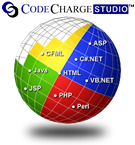
Delphi is a general-purpose programming language and a software product that uses the Delphi dialect of the Object Pascal programming language and provides an integrated development environment (IDE) for rapid application development of desktop, mobile, web, and console software, currently developed and maintained by Embarcadero Technologies.
Web development is the work involved in developing a website for the Internet or an intranet. Web development can range from developing a simple single static page of plain text to complex web applications, electronic businesses, and social network services. A more comprehensive list of tasks to which Web development commonly refers, may include Web engineering, Web design, Web content development, client liaison, client-side/server-side scripting, Web server and network security configuration, and e-commerce development.

WebGUI is an open-source content management system written in Perl and released under the GNU General Public License.
eZ Publish is an open-source enterprise PHP content management system that was developed by the Norwegian company Ibexa. eZ Publish is now maintained by 7x. eZ Publish is freely available under the GNU GPL version 2 license, as well as under proprietary licenses that include commercial support. In 2015, eZ Systems introduced eZ Platform to replace eZ Publish with a more modern and future-proof solution. In 2024, 7x released eZ Publish 6.0 (stable) to replace eZ Publish 5.4 with a more modern and future-proof solution compatible with PHP 7.x and 8.x software. In 2024/02 7x followed up its first release (6.0) with a powerful second release 6.0.1 containing key installation bugfixes and a brand new database backend for flat file database called SQLite that is mature and stable ready to use to simplify your website or web application. In 2024/03 7x continues to develop and release monthly updates to eZ Publish with the release of version 6.0.2 which provides default design improvements and many more extensions enabled for use by default.
In computing, a solution stack or software stack is a set of software subsystems or components needed to create a complete platform such that no additional software is needed to support applications. Applications are said to "run on" or "run on top of" the resulting platform.

Django is a free and open-source, Python-based web framework that runs on a web server. It follows the model–template–views (MTV) architectural pattern. It is maintained by the Django Software Foundation (DSF), an independent organization established in the US as a 501(c)(3) non-profit.

A LAMP is one of the most common software stacks for the web's most popular applications. Its generic software stack model has largely interchangeable components.

Catalyst is an open-source web application framework written in Perl. It closely follows the model–view–controller (MVC) architecture and supports a number of experimental web patterns. It is written using Moose, a modern object system for Perl. Its design is heavily inspired by frameworks such as Ruby on Rails, Maypole, and Spring.
Laminas Project is an open source, object-oriented web application framework implemented in PHP 7 and licensed under the New BSD License. The framework is basically a collection of professional PHP-based packages. The framework uses various packages by the use of Composer as part of its package dependency managers; some of them are PHPUnit for testing all packages, Travis CI for continuous Integration Services. Laminas provides to users a support of the model–view–controller (MVC) in combination with Front Controller solution. MVC implementation in Laminas has five main areas. The router and dispatcher functions to decide which controller to run based on data from URL, and controller functions in combination with the model and view to develop and create the final web page.
Scaffolding, as used in computing, refers to one of two techniques:

A template processor is software designed to combine templates with data to produce resulting documents or programs. The language that the templates are written in is known as a template language or templating language. For purposes of this article, a result document is any kind of formatted output, including documents, web pages, or source code, either in whole or in fragments. A template engine is ordinarily included as a part of a web template system or application framework, and may be used also as a preprocessor or filter.
Qcodo is an open-source PHP web application framework which builds an object-relational model (ORM), CRUD UI pages, and AJAX hooks from an existing data model. It additionally includes a tightly integrated HTML and JavaScript form toolkit which interfaces directly with the generated entities. It is a robust, comprehensive framework which can be utilized by small and large Web applications alike.
Web2py is an open-source web application framework written in the Python programming language. Web2py allows web developers to program dynamic web content using Python. Web2py is designed to help reduce tedious web development tasks, such as developing web forms from scratch, although a web developer may build a form from scratch if required.

Scriptcase is a Low-code plataform for Rapid application development that works as a code generator for PHP web applications, and is based on the same script language. It is web oriented and can be installed on an intranet or internet server. Developers use a graphical interface to design and generate code. The software was developed by NetMake in 2000 and can be used on Mac, Windows, and Linux operating systems.
The following outline is provided as an overview of and topical guide to the Perl programming language:

Fat-Free Framework is an open-source web framework distributed under the GNU General Public License and hosted by GitHub and SourceForge. The software seeks to combine a full featureset with a lightweight code base while being easy to learn, use and extend.
The following outline is provided as an overview of and topical guide to web design and web development, two very related fields:








